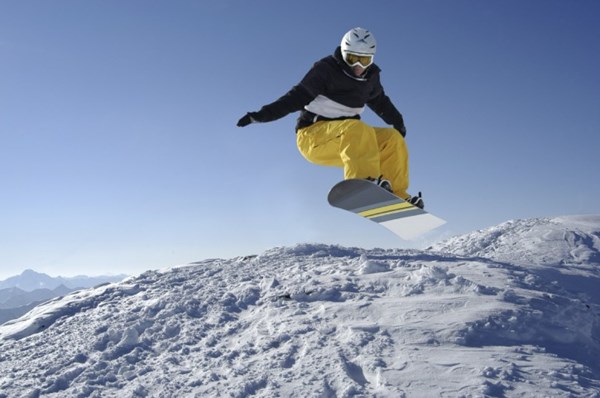TORONTO, Dec. 15, 2015 (GLOBE NEWSWIRE) -- Winter is an exciting time for anyone who loves cold weather sports, such as snowboarding, skiing, and hockey. And frankly, none of these sports would exist in current form without plastics.
Innovations in plastics have enabled more lightweight, durable, and responsive equipment, as well as tougher protective gear and better insulated, water resistant clothing – helping athletes achieve high levels of performance while facing winter's cold and fury.
Here are some of the ways plastics play an important role in snowboarding, skiing, and hockey… and some new innovations.
Snowboarding
Modern snowboards often are made with a polyurethane foam plastic core that makes the board strong but lightweight. This core is wrapped in high-tech plastic materials, such as glass-reinforced plastics or tough plastic fibers such as Kevlar®, for added strength and durability. The base of the board is typically made with polyethylene plastic that is slightly porous so it can absorb wax for a smooth glide on the snow.
Snowboarders wear boots made with plastics such as nylon that are chosen for durability and a very favourable strength-to-weight ratio. These lightweight boots can be both insulating and sturdy; keeping feet warm while reducing the energy it takes to hike to the lift. And these boots often are held to the board with plastic bindings.
Many snowboarders depend on plastics to improve safety, from kneepads to wrist guards to hip pads – and, of course, the shock absorbing, cushioning helmets made from hard and soft plastics. Goggles with impact-resistant polycarbonate plastic lenses help protect eyes from snow, wind, debris – even UV rays.
What's new? A snowboard manufacturer is using a bio-plastic to make the top sheet for some of its boards. Made partially from castor bean oil, BEANS is a plastic that provides a great strength-to-weight ratio, which means it helps protects the board and makes it stronger and springier, according to the manufacturer. BEANS is used in boards by Lib Tech.
Skiing
Skis have come a long way, from bone, wood and metal versions to today's high tech plastics. Modern models often have a core made with lightweight polyurethane plastic. And similar to snowboards, this core often is wrapped with glass-reinforced plastic for strength, and the bottom of the ski is coated with slick polyethylene plastic.
The first plastic ski boots were created in the 1960's to be more water-resistant and supportive than previous ski boots. Inside the hard plastic shell, plastic fabric liners and foam provide cushion and insulation. Technological innovations in plastics and boot construction create a more efficient energy transfer between the athlete and skis, which has allowed skiers to dramatically increase their speed and control.
Skiers also use similar safety gear as snowboarders.
What's new? Ski bindings from companies such as KneeBindings, made with super-strong, carbon-fiber-reinforced plastics, are designed to release a skier's foot laterally during a fall. KneeBindings says its product can reduce the chance of painful ligament injuries that might require surgery, compared to bindings that release only from the heel or toe.
Hockey
Traditional hockey sticks were made with wood, but today many are made with composite plastics, such as glass- and carbon-fibre-reinforced plastics, and tough plastic fibres such as Kevlar® to improve their performance. Early hockey skates were made of leather, but today they're made with a wide variety of plastics to cushion the feet and provide sturdy ankle support for increased stability and agility.
The safety "glass" used at many hockey rinks isn't glass at all – it's a transparent acrylic plastic called Plexiglas®, which is installed in a way that helps it be a bit more "impact-friendly" than glass for checked players. The primary safety measure for players, though, is the player's gear. Hockey helmets are engineered with a crack-resistant outer plastic shell (often vinyl nitrile) and various plastic foam liners to absorb impact and disperse force. The helmet often is equipped with a visor made with transparent, impact-resistant polycarbonate plastic. Other protective gear includes a mouth guard, a neck guard, gloves, elbow pads, shoulder pads, an athletic protector, padded shorts, and shin guards—all made with plastics.
What's new? Various soft foam and rigid plastics combine to make comfortable yet sturdy foot bed inserts for hockey skates (and numerous other sports shoes and boots). The manufacturer, Superfeet, says these inserts help keep a player's knees from bending inward while skating, which reduces knee pain and foot cramps while providing extra power and control on the ice.
Plastic Innovations Continue …
Chemists, engineers and others continue to develop new innovations in plastics that contribute to winter sports safety and performance. And fortunately you don't need to be a professional athlete to take advantage of the latest state-of-the-art gear.
Today's intelligent plastics are vital to the modern world. These materials enhance our lifestyles, our economy and the environment. For more information visit www.intelligentplastics.ca.
A photo accompanying this release is available at: http://www.globenewswire.com/newsroom/prs/?pkgid=38177
